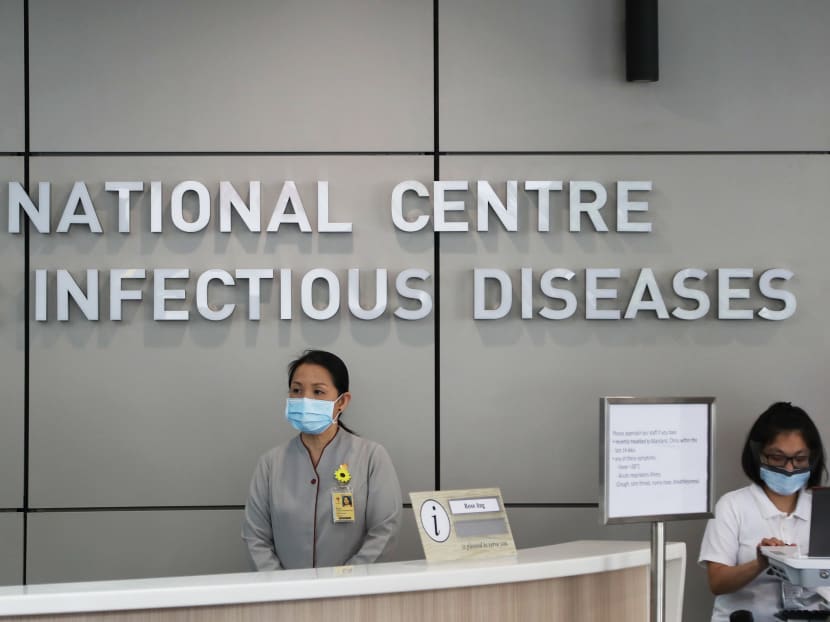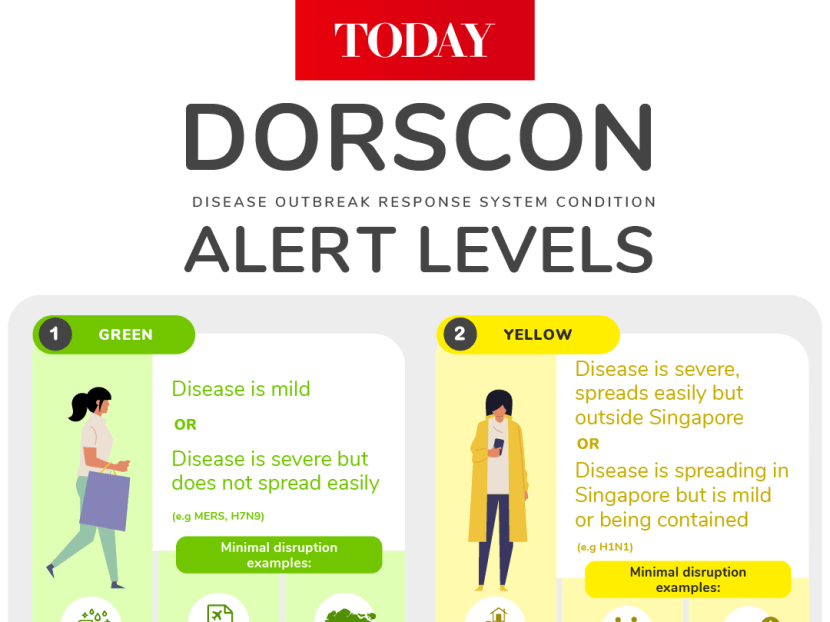Novel coronavirus: S’pore moves to Dorscon Orange, as 3 new cases confirmed with no apparent link to previous cases or recent travel to China
SINGAPORE — The Government has raised its risk assessment level of the novel coronavirus situation in Singapore to Dorscon Orange, as it announced that there are three new infected patients here.

Dorscon Orange refers to a situation in which a virus is spreading in Singapore but not widely, and is being contained. The Government is encouraging event organisers to cancel or defer non-essential large-scale events.
SINGAPORE — The Government has raised its risk assessment level of the novel coronavirus situation in Singapore to Dorscon Orange, as it announced that there are three new infected patients here.
The Ministry of Health (MOH) said on Friday (Feb 7) that it was making this move because there are now a few local cases, including the latest three, without any apparent links to previous cases or travel history to China.
Under Singapore's crisis management plan known as the Disease Outbreak Response System (Dors), Dors condition (Dorscon) Orange refers to a situation in which a virus is spreading in Singapore but not widely, and is being contained.
Previously, the risk assessment level was at Dorscon Yellow, signifying that the virus was severe and could infect from person to person, but was chiefly occurring outside Singapore.
With the move to Dorscon Orange, the Government is encouraging event organisers to cancel or defer non-essential large-scale events.
MOH said that all employers should now require staff members to check their temperatures at least twice daily and step up their business continuity plans in preparation for widespread community transmission.
Hospitals and schools will also be required to step up measures to minimise the risk of transmission. For example, schools will be suspending inter-school and external activities until the end of the March school holidays, with immediate effect, while hospitals will care for pneumonia patients separately from other patients.
Speaking at a press conference, Health Minister Gan Kim Yong said: “As our hospitals continue to remain on high alert, we expect to see more of such cases (of local transmission) in future. I understand that Singaporeans are anxious and concerned that there is much we do not yet know about the virus.”
National Development Minister Lawrence Wong said that despite Singapore’s best efforts to contain, ringfence and isolate patients, there is still the possibility of wider community spread.
“If it is so, we have to reassess the situation if it worsens and take more stringent measures beyond what we are announcing today.”
He added that the scenario could develop in a different direction, too.
“If you look at the situation now, the mortality rate in China is 2 per cent, but outside of Hubei province, the mortality rate for this virus is 0.2 per cent, much lower than that of Sars (severe acute respiratory syndrome).
“If the mortality rate remains low or continues to fall further, then I think we are dealing with something quite different, and then we have to consider a different approach.”
Mr Wong noted that these are “challenging times” and that Singaporeans are anxious and worried.
“We are doing our best to put in place effective measures to defend Singapore and defend Singaporeans,” he said.
Mr Gan added: “We expect this will take some time. Life should not come to a standstill but we should take all necessary precautions and go on with life.”
Later, reporters asked Mr Gan under what circumstances would the authorities revert the Dorscon level to Yellow.
He explained that Singapore has raised the level to Orange primarily due to the four cases, but there may be “opportunities” to lower the risk assessment level to Yellow or Green, depending on how the situation evolves.
“Let’s say, for example, if we are able to contain the cases and are able to determine the sources of infection for the cases that we know, and those for which we have not determined the sources have recovered, are discharged and no longer infectious, then we will consider stepping back from Orange to Yellow, where we were at yesterday,” he said.
Associate Professor Kenneth Mak, director of medical services at MOH, added that in the H1N1 flu outbreak in Singapore in 2009, the Dorscon level had also been raised to Orange but was later lowered.
Said Assoc Prof Mak: “As we had a better understanding of that illness, we realise that its behaviour is similar to other forms of influenza. It provided us with the opportunity to re-assess the risks associated with H1N1 and then lower our Dorscon accordingly.”
H1N1 did not receive as much attention as the severe acute respiratory syndrome pandemic in 2003 as the viral outbreak was not as fatal and a vaccine was available. It infected more than 400,000 people in Singapore and killed 18.

THE THREE NEW CASES
Case #31
-
A 53-year-old male Singaporean with no recent travel history to China.
-
He was in Malaysia on Jan 6, 11 and 17.
-
He is warded in an isolation room at Changi General Hospital (CGH).
-
He reported the onset of symptoms on Jan 23 and visited a general practitioner (GP) on the same day.
-
He visited another GP on Jan 28 and was admitted to CGH on Feb 1.
-
Subsequent test results at about 11pm on Feb 6 confirmed that he had the novel coronavirus.
-
He lives on Tampines Street 24. Before being admitted to CGH, he had been to The Life Church and Missions Singapore along Macpherson Road and had visited family and friends during Chinese New Year.
Case #32
-
A 42-year-old female Singaporean with no recent travel history to China.
-
She was warded in an isolation room at Parkway East Hospital but has since been transferred to the National Centre for Infectious Diseases.
-
She reported an onset of symptoms on Feb 2 and was admitted to Parkway East Hospital on Feb 5.
-
Test results around 11pm on Feb 6 confirmed that she had the virus.
-
She works at Victoria Junior College but has had no interactions with colleagues or students since the onset of her symptoms.
-
She was last in school on Jan 31, and those who had close contact with her have been placed on a 14-day leave of absence.
-
The college's staff members will be decontaminating the areas of the college campus that the teacher was in and co-curricular activities have been cancelled.
-
The patient lives on Elias Road in Pasir Ris and recently went to the Singapore Zoo and Changi Airport.
Case #33
-
A 39-year-old female Singaporean with no recent travel history to China.
-
She was in Malaysia from Jan 22 to 29.
-
She is warded in an isolation room at Sengkang General Hospital (SKH).
-
She reported that she had developed symptoms on Jan 30 and on Feb 2, she went to the emergency department at SKH, where she was admitted.
-
Test results at about 11pm on Feb 6 confirmed that she had the virus.
UPDATES ON EARLIER CASES
Case #30
-
A 27-year-old Singaporean man who had attended a business meeting at the Grand Hyatt Singapore from Jan 20 to 22.
-
Before being admitted to hospital, he had gone to Far East Square near Chinatown and Junction 8 in Bishan, and lives on Shunfu Road near Marymount Road.
Among the confirmed cases, two have been discharged. Of the remaining 31 patients, most are stable or improving, MOH said. Two are in critical condition in the intensive care unit.











